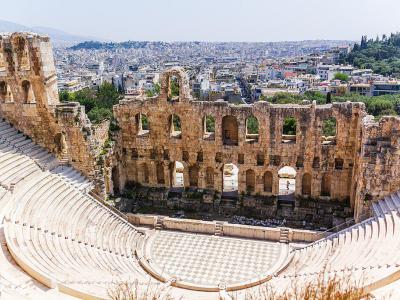
Odeon of Herodes Atticus, Athens
The Odeon of Herodes Atticus—or, as locals call it, the Herodeion. This name sounds like it belongs to an ancient superhero, but in reality, it’s a grand stone amphitheater sitting snug at the foot of the Acropolis. Built in 161 AD by a Greek aristocrat with a Roman title, Herodes Atticus, this wasn’t just any vanity project—it was a love letter to his late wife. And what better way to say “I miss you” than with a massive, acoustically perfect concert hall?
Originally, the Herodeion played host to the finest musical and theatrical performances of the ancient world—think tragic dramas, soaring choral arrangements, and instrumental masterpieces. The kind of cultural flex that made Athens the place to be. With no remnants of a roof (aside from the cedar one that once covered the orchestra area), this was an open-air spectacle from the very start.
A couple of millennia on, the Herodeion is still in business. By day, it’s a stunning ruin that whispers tales of the past. By night, it transforms into one of the dreamiest venues on Earth, hosting classical concerts, modern theater, and international acts beneath the Athenian moon.
Tip:
If you're planning a trip to Athens, check the event schedule ahead of time—nothing ruins a perfect ancient Greek night out like realizing all the tickets are gone. And since this is an open-air gig, always keep an eye on the weather. Rain or shine, though, this place remains one of the most breathtaking remnants of an era when entertainment was truly larger than life.
Originally, the Herodeion played host to the finest musical and theatrical performances of the ancient world—think tragic dramas, soaring choral arrangements, and instrumental masterpieces. The kind of cultural flex that made Athens the place to be. With no remnants of a roof (aside from the cedar one that once covered the orchestra area), this was an open-air spectacle from the very start.
A couple of millennia on, the Herodeion is still in business. By day, it’s a stunning ruin that whispers tales of the past. By night, it transforms into one of the dreamiest venues on Earth, hosting classical concerts, modern theater, and international acts beneath the Athenian moon.
Tip:
If you're planning a trip to Athens, check the event schedule ahead of time—nothing ruins a perfect ancient Greek night out like realizing all the tickets are gone. And since this is an open-air gig, always keep an eye on the weather. Rain or shine, though, this place remains one of the most breathtaking remnants of an era when entertainment was truly larger than life.
Want to visit this sight? Check out these Self-Guided Walking Tours in Athens. Alternatively, you can download the mobile app "GPSmyCity: Walks in 1K+ Cities" from Apple App Store or Google Play Store. The app turns your mobile device to a personal tour guide and it works offline, so no data plan is needed when traveling abroad.
Odeon of Herodes Atticus on Map
Sight Name: Odeon of Herodes Atticus
Sight Location: Athens, Greece (See walking tours in Athens)
Sight Type: Attraction/Landmark
Guide(s) Containing This Sight:
Sight Location: Athens, Greece (See walking tours in Athens)
Sight Type: Attraction/Landmark
Guide(s) Containing This Sight:
Walking Tours in Athens, Greece
Create Your Own Walk in Athens
Creating your own self-guided walk in Athens is easy and fun. Choose the city attractions that you want to see and a walk route map will be created just for you. You can even set your hotel as the start point of the walk.
Plaka Attractions Walking Tour
Plaka, the oldest—and in many views, the most photogenic—district of Athens is where history isn’t just studied, it’s lived. Nestled at the foot of the mighty Acropolis, this is the "neighborhood of the Gods"—which sounds dramatic, but when you see it, you’ll understand why.
People have settled here since antiquity, so don’t be surprised if the walls seem to whisper... view more
Tour Duration: 2 Hour(s)
Travel Distance: 3.6 Km or 2.2 Miles
People have settled here since antiquity, so don’t be surprised if the walls seem to whisper... view more
Tour Duration: 2 Hour(s)
Travel Distance: 3.6 Km or 2.2 Miles
Athens Introduction Walking Tour
Athens, the cradle of Western Civilization and one of Europe's oldest cities, originated between the 4th and the 3rd millennia BC. The story of Athens stems from a mythological contest between the goddess of wisdom and warfare, Athena, and the god of the sea, Poseidon. Both deities vied to become the city's patron. Poseidon's gift of a saltwater spring was deemed impractical,... view more
Tour Duration: 3 Hour(s)
Travel Distance: 4.2 Km or 2.6 Miles
Tour Duration: 3 Hour(s)
Travel Distance: 4.2 Km or 2.6 Miles
Walking Tour Around the Legendary Acropolis
Ah, the Acropolis of Athens—also known as "the sacred rock," because apparently, even rocks can have VIP status. This iconic hill has been home to temples, sanctuaries, and centuries of drama (both the theatrical and the historical kind). The ancient Greeks held this place in such high regard that they built architectural marvels that still dominate the city’s skyline. You can spot... view more
Tour Duration: 1 Hour(s)
Travel Distance: 1.0 Km or 0.6 Miles
Tour Duration: 1 Hour(s)
Travel Distance: 1.0 Km or 0.6 Miles
Walking Around the National Garden
The National Garden is an impressive, historic park in the center of Athens, complete with artificial streams and duck ponds. Formerly known as the Royal Garden, it was commissioned by King Otto’s queen, Amalia, in 1838, reason why it is located directly behind the Old Palace (currently the Greek Parliament building). Not only is it a welcome refuge from the swirl of traffic just outside the... view more
Tour Duration: 2 Hour(s)
Travel Distance: 3.4 Km or 2.1 Miles
Tour Duration: 2 Hour(s)
Travel Distance: 3.4 Km or 2.1 Miles
Athens Food Walking Tour
Traditional Greek cuisine is one of the healthiest in the world, and prices in all but the flashiest establishments afford excellent value. The prevalence of vegetable and dairy dishes makes eating out a delight for non-meat eaters. Carefully selected appetizers (tzatzíki, dolmádes, kalamarákia) can constitute a full meal. Greece’s most famous slow-cooked oven dish, however, is probably... view more
Tour Duration: 1 Hour(s)
Travel Distance: 2.2 Km or 1.4 Miles
Tour Duration: 1 Hour(s)
Travel Distance: 2.2 Km or 1.4 Miles
Useful Travel Guides for Planning Your Trip
Souvenirs Shopping: 19 Uniquely Greek Products to Bring from Athens
A cradle of European civilization, Greece, in general, and Athens, in particular, have long been - from the days of the Roman Empire up until present - the lure for travelers and history buffs seeking to find and bring home something memorable. Today's Athens (much as its ancient self) offers a...
15 Best Cafes in Athens
While in Athens it is immediately noticeable that the local cafe culture thriving. Through this directory you will get a chance to visit very different establishments, ranging from "kafenia", to hip, modern coffee shops and get first hand experience of the diversity of contemporary Greek...
A Self-Guided Food Walk in Athens
Just as many things in Greece, dining in Athens is very much laid-back with the majority of local eateries seeing patrons begin to congregate for dinner only after 8 pm. Eating-wise, the Athenians favor simplicity, leaning to the more casual and not so pricey tavernas where food is plentiful. To...








